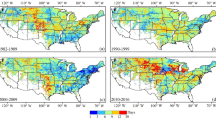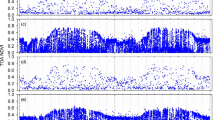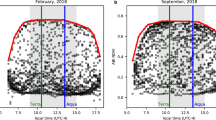Abstract
Previous studies have documented substantial advancing trends in the onset date of vegetation green-up (VGD) during the 1980s and 1990s over the Northern Hemisphere, while later studies based on data from the spaceborne advanced very high-resolution radiometer (AVHRR) have reported this trend stalled during the warming hiatus from the late 1990s to early 2010s. However, there is uncertainty in this finding of a hiatus in VGD advance due to the identification of quality issues associated with the data from AVHRR. Using the high-quality data from the Moderate Resolution Imaging Spectroradiometer, we show VGD significantly advanced despite the warming hiatus due to the high sensitivity of VGD to temperature and the magnitude of VGD advance over 2000–2021 (2.5–2.6 days decade–1, P < 0.01) is close to that over 1982–1999 or 1982–2002 with intensive warming, which suggests caution be exercised in the inference of climate warming based on advances in spring phenology.
Similar content being viewed by others
The onset date of vegetation green-up (VGD) is widely used as an indicator of ecosystem response to climate change, due to its sensitivity to warming and its role in a variety of ecosystem and climate system processes1,2,3. While analyses of in situ and satellite observation data show substantial and widespread advances in VGD associated with global warming during the 1980s and 1990s4,5, recent satellite-based studies have reported a stall in these advances from the late 1990s to the early 2010s6,7, due to a warming hiatus8,9. However, this reported halt in VGD advance could be open to question, given that the analyses were based on the normalized difference vegetation index (NDVI) data derived from the advanced very high-resolution radiometer (AVHRR) sensor (AVHRR NDVI3g.v1)10 that has quality issues11 and has produced estimates of interannual changes in VGD since the early 2000s that differ substantially from those derived from other high-quality satellite products, such as NDVI data derived from moderate resolution imaging spectroradiometer (MODIS) and SPOT VEGETATION12,13.
Furthermore, questions may be asked concerning the attribution of this reported stall in VGD advance to a warming hiatus, given that the hiatus was based on the annual mean air temperature8,9, whereas the interannual changes in VGD were driven by the temperature of a given period (mostly from two weeks to two months) preceding the VGD (pre-VGD temperature)14 and that warming hiatus of annual mean temperature may not necessarily reflect a stall in warming of pre-VGD temperature. In addition, the warming hiatus might have ended as a result of accelerated warming since 201515. However, it is not known whether there was an accelerated increase in pre-VGD temperature. If the temporal changes of pre-VGD temperature were similar to those of mean annual temperatures, there might be a turning point in the trend of pre-VGD temperature.
In this study, we used the high-quality MODIS NDVI dataset and climate data from the European Centre for Medium-Range Weather Forecasts Reanalysis v5-Land (ERA5-Land) dataset to test for hiatuses in warming of pre-VGD temperature and VGD advance at mid- and upper-latitudes (30–75°N) of the northern hemisphere (NH), between the late 1990s and early 2010s. Here, we used both the threshold- and inflection point-based methods13,16 to determine VGD from annual NDVI trajectories (see Supplementary Methods for details). Then, we tested for turning points in the temporal trends in pre-VGD temperature and VGD to confirm acceleration in warming of the pre-VGD temperature following warming hiatus periods and identified associated VGD responses.
Of the 12 different periods between the late 1990s and early 2010s, during which previous studies identified a hiatus in warming of annual mean temperature8,9,15, we found evidence for increases in pre-VGD temperature averaged over the NH (for details, see Supplementary Methods) over the single period of 2001–2014 (1.0 °C decade–1, P < 0.05), while in eight of the remaining 11 periods with hiatuses in warming of pre-VGD temperature, there were advances in VGD (2.2–4.0 days decade–1; P < 0.05) determined by the threshold-based method (Fig. 1a). The VGD determined by the inflection point-based showed similar changes (Supplementary Fig. 1a). In the following results, we report changes in VGD and associated pre-VGD temperature for the threshold-based method unless specifically stated.
Temporal trends in pre-VGD temperature and VGD averaged over the mid- and upper-latitudes (30–75°N) of the Northern Hemisphere (NH) during the warming hiatuses reported in previous studies (a), over the NH, Eurasia, and North America, respectively, during 2000–2021 (b), and over the NH during the periods of different lengths starting between 2000 and 2012 (c, d). Positive and negative trends in VGD indicate delay and advance, respectively. *P < 0.05 and **P < 0.01. VGD is determined by the threshold-based method (see Supplementary Methods) as the first date when NDVI increases by 20% of the annual amplitude in the ascending period of the annual NDVI trajectory. VGD was derived from MODIS NDVI since 2000 and from AHVRR NDVI3g.v1 in 1998 and 1999 (see Supplementary Methods).
Analysis of the corrected Akaike information criterion (AICC) to test for turning points in pre-VGD temperature over the NH between 2000 and 2021 showed better estimation using a linear regression model than a piecewise model (see Supplementary Methods). Similarly, a t-test indicated that the turning point of the pre-VGD temperature trend estimated by piecewise regression was not significant (P = 0.25). Hence, there was no turning point in the pre-VGD temperature averaged over the NH during 2000–2021. Likewise, we found no evidence for turning points in the average pre-VGD temperature over Eurasia (AICC; t-test P = 0.39) or North America (AICC; t-test P = 0.54) (Supplementary Table 1). Consistently, we identified turning points in pre-VGD temperature for 3.7% (AICC; Fig. 2a) and 7.3% (t-test P < 0.05; Supplementary Fig. 2a) of the NH area. Similarly, we found no evidence for turning points of average VGD over the NH (AICC; t-test P = 0.26), Eurasia (AICC; t-test P = 0.48), or North America (AICC; t-test P = 0.40) (Supplementary Table 1) and identified turning points in VGD for 6.7% (AICC; Fig. 2b) and 11.0% (t-test P < 0.05; Supplementary Fig. 2b) of the NH area. The VGD determined by the inflection point-based method also produced results supporting the lack of turning point in the trends of pre-VGD temperature and VGD (Supplementary Table 1 and Supplementary Fig. 3a–d).
Blue pixels indicate turning points determined by the corrected Akaike information criterion (see Supplementary Methods) in a pre-VGD temperature and b VGD trends during 2000–2021. c, d Linear regression modeling of trends in pre-VGD temperature and VGD over the period 2000–2021. VGD is determined by the threshold-based method as the first date when NDVI increases by 20% of the annual amplitude in the ascending period of the annual NDVI trajectory.
Over the period 2000–2021, average VGD across the NH advanced by 2.5 days decade–1 (P < 0.01) and there was an increase of 0.5 °C decade–1 in pre-VGD temperature (P < 0.05; Fig. 1b), despite a lack of significant trends in pre-VGD temperature and VGD since 2009 (Fig. 1c, d). The main contribution to the pre-VGD warming and VGD advance across the NH over this period was from Eurasia, where average pre-VGD temperature increased by 0.8 °C decade–1 (P < 0.05) and VGD advanced by 3.1 days decade–1 (P < 0.01; Fig. 1b). In contrast, there were no changes in average pre-VGD temperature or VGD in North America during the period 2000–2021 (P > 0.05; Fig. 1b). The VGD determined by the inflection point-based method showed similar temporal changes (Supplementary Fig. 1b–d).
These results indicate that changes in the pre-VGD temperature and VGD were continuous from 2000 to 2021, with warming pre-VDG temperature and advancing VGD recorded in most areas of the NH (Fig. 2c, d), where the temperature increased and VGD advanced in Eastern America, Alaska, western Canada and most areas of Eurasia, whereas the temperature cooled and VGD delayed in limited areas of Eastern Canada and Northern Europe. There were a similar spatial pattern of trends in pre-VGD temperature and VGD based on the inflection-based method (Supplementary Fig. 3e–f).
Consistent with previous reports of the stalling of advances in VGD and identification of hiatuses in warming across the NH between the late 1990s and early 2010s6,7 based on the AVHRR NDVI3g.v1 dataset, our analyses of this dataset showed similar results (Supplementary Fig. 4). However, our analyses of different sources of satellite data revealed evidence for continued advances in VGD throughout these periods (Fig. 1a and Supplementary Fig. 1a). Whereas the previous studies were based on analysis AVHRR NDVI3g.v1 data, for which quality issues have been identified for data collected post-200011, our analyses were based on high-quality MODIS NDVI data17 collected using a sensor that lacks the problems associated with the AVHRR sensor (Supplementary Methods), leading to greater confidence. Moreover, our results showed that the continuous increases in pre-VGD temperature across the NH during the entire period 2000–2021 were associated with an increase in pre-VGD temperature since the early 2000s and small temperature trends during the 2010s (Fig. 1b, c and Supplementary Fig 1b, c), rather than accelerated warming following a warming hiatus between the late 1990s and early 2010s8,9. In response to the pre-VGD temperature, we found a continuing advance in VGD, including most periods starting from the end of the 1990s, despite a lack of substantial warming of pre-VGD temperature in the corresponding period (Fig. 1 and Supplementary Fig. 1). The advancing rate of VGD (2.5–2.6 days decade–1, Fig. 1b and Supplementary Fig. 1b) averaged over the NH during 2000–2021 is close to 1.9–2.8 days decade–1 over 1982–1999 or 1982–2002 when there was intensive warming18,19.
The phenology of vegetation in spring is particularly sensitive to changes in temperature, so small temperature increases may lead to substantial advances in VGD;20 similarly, increases in precipitation that have been reported to advance spring phenology in some dry grasslands21 may explain the advances in VGD shown here. Research in some cold areas has shown that warming outside the growing season may facilitate earlier fulfillment of chilling requirements, leading to earlier VGDs;22 indeed, our findings indicate that advances in spring phenology may not necessarily indicate overall climate warming, so we suggest caution be exercised in the inference of climate warming based on advances in spring phenology.
Nevertheless, our results show that spring temperature has continuously increased across the NH over the period 2000‒2021, resulting in a continuous advancement of spring phenology that might have contributed to subsequent increases in spring gross primary production23 and accelerated net carbon uptake24 during the warming hiatus. It is likely that earlier spring green-up may increase the likelihood of summer drought effects, due to enhanced transpiration rates2, that then reduce vegetation productivity25. Our finding of advances in spring phenology during the warming hiatus also supports an increased risk of spring frost damage during ongoing global warming26. Our results thus deepen understanding of spring phenology responses to recent climate change, especially during the warming hiatus that occurred between the late 1990s and early 2010s, with substantial implications for impacts on carbon-climate feedback.
Summary of materials and methods
We determined VGD from the NDVI time series for the study period, extracted from the MOD13C1 Version 6 product, after the elimination of data recorded under the presence of snow, ice, clouds, and aerosols. The pre-VGD period with the strongest potential influence on VGD was defined as the period preceding the multi-year mean VGD, for which the absolute value of the partial correlation coefficient of mean temperature with VGD was maximized, while controlling for the effect of precipitation and radiation. Daily climatic data were obtained from the ERA5-Land dataset. Temporal changes in pre-VGD temperature and VGD were assessed using linear regression modeling. To test for turning points in the temporal trends of pre-VGD temperature and VGD, we compared linear and piecewise regression model predictions of pre-VGD temperature (or VGD), using the corrected Akaike information criterion and t-test, respectively. For further information see the Supplementary Methods.
Data availability
All data used for this study are publicly available online.
Code availability
The codes that support the findings of this study are available on request from the corresponding author.
References
Peñuelas, J., Rutishauser, T. & Filella, I. Phenology feedbacks on climate change. Science 324, 887 (2009).
Lian, X. et al. Summer soil drying exacerbated by earlier spring greening of northern vegetation. Sci. Adv. 6, eaax0255 (2020).
Shen, M. et al. Plant phenology changes and drivers on the Qinghai–Tibetan Plateau. Nat. Rev. Earth Environ. 3, 633–651 (2022).
Menzel, A. et al. Climate change fingerprints in recent European plant phenology. Glob. Change Biol. 26, 2599–2612 (2020).
Piao, S. et al. Plant phenology and global climate change: current progresses and challenges. Glob. Change Biol. 25, 1922–1940 (2019).
Wang, X. et al. No trends in spring and autumn phenology during the global warming hiatus. Nat. Commun. 10, 2389 (2019).
Park, H., Jeong, S.-J., Ho, C.-H., Park, C.-E. & Kim, J. Slowdown of spring green-up advancements in boreal forests. Remote Sens. Environ. 217, 191–202 (2018).
IPCC. Summary for Policymakers (Cambridge Univ. Press, 2013).
Fyfe, J. C. et al. Making sense of the early-2000s warming slowdown. Nat. Clim. Change 6, 224–228 (2016).
Pinzon, J. & Tucker, C. A non-stationary 1981–2012 AVHRR NDVI3g time series. Remote Sens. 6, 6929–6960 (2014).
Ye, W., van Dijk, A. I. J. M., Huete, A. & Yebra, M. Global trends in vegetation seasonality in the GIMMS NDVI3g and their robustness. Int. J. Appl. Earth Obs. Geoinf. 94, 102238 (2021).
Zhang, J. et al. Comparison of land surface phenology in the Northern Hemisphere based on AVHRR GIMMS3g and MODIS datasets. ISPRS J. Photogramm. Remote Sens. 169, 1–16 (2020).
Wang, X. et al. No consistent evidence for advancing or delaying trends in spring phenology on the Tibetan Plateau. J. Geophys. Res. Biogeosci. 122, 3288–3305 (2017).
Shen, M. et al. Greater temperature sensitivity of vegetation greenup onset date in areas with weaker temperature seasonality across the Northern Hemisphere. Agric. For. Meteorol. 313, 108759 (2022).
Zhang, C., Li, S., Luo, F. & Huang, Z. The global warming hiatus has faded away: an analysis of 2014–2016 global surface air temperatures. Int. J. Climatol. 39, 4853–4868 (2019).
Gonsamo, A., Chen, J. M. & D’Odorico, P. Deriving land surface phenology indicators from CO2 eddy covariance measurements. Ecol. Indic. 29, 203–207 (2013).
Huete, A. et al. Overview of the radiometric and biophysical performance of the MODIS vegetation indices. Remote Sens. Environ. 83, 195–213 (2002).
Jeong, S.-J., Ho, C.-H., Gim, H.-J. & Brown, M. E. Phenology shifts at start vs. end of growing season in temperate vegetation over the Northern Hemisphere for the period 1982-2008. Glob. Change Biol. 17, 2385–2399 (2011).
Wang, S. et al. Temporal trends and spatial variability of vegetation phenology over the northern hemisphere during 1982–2012. PLoS ONE 11, e0157134 (2016).
Chen, L. et al. Spring phenology at different altitudes is becoming more uniform under global warming in Europe. Glob. Change Biol. 24, 3969–3975 (2018).
Ren, S., Yi, S. Peichl, M. & Wang, X. Diverse responses of vegetation phenology to climate change in different grasslands in inner Mongolia during 2000–2016. Remote Sens. 10, 17 (2017).
Vitasse, Y., Signarbieux, C. & Fu, Y. H. Global warming leads to more uniform spring phenology across elevations. Proc. Natl Acad. Sci. USA 115, 1004–1008 (2018).
Zhu, Z. et al. The accelerating land carbon sink of the 2000s may not be driven predominantly by the warming Hiatus. Geophys. Res. Lett. 45, 1402–1409 (2018).
Ballantyne, A. et al. Accelerating net terrestrial carbon uptake during the warming hiatus due to reduced respiration. Nat. Clim. Change 7, 148–152 (2017).
Zhou, X. et al. Legacy effect of spring phenology on vegetation growth in temperate China. Agric. For. Meteorol. 281, 107845 (2020).
Liu, Q. et al. Extension of the growing season increases vegetation exposure to frost. Nat. Commun. 9, 426 (2018).
Acknowledgements
This work was funded by the Fundamental Research Funds for the Central Universities.
Author information
Authors and Affiliations
Contributions
M.S. designed research; N.J. and M.S. performed research; N.J. analyzed data; all the authors interpreted the results and wrote the paper.
Corresponding author
Ethics declarations
Competing interests
The authors declare no competing interests.
Additional information
Publisher’s note Springer Nature remains neutral with regard to jurisdictional claims in published maps and institutional affiliations.
Supplementary information
Rights and permissions
Open Access This article is licensed under a Creative Commons Attribution 4.0 International License, which permits use, sharing, adaptation, distribution and reproduction in any medium or format, as long as you give appropriate credit to the original author(s) and the source, provide a link to the Creative Commons license, and indicate if changes were made. The images or other third party material in this article are included in the article’s Creative Commons license, unless indicated otherwise in a credit line to the material. If material is not included in the article’s Creative Commons license and your intended use is not permitted by statutory regulation or exceeds the permitted use, you will need to obtain permission directly from the copyright holder. To view a copy of this license, visit http://creativecommons.org/licenses/by/4.0/.
About this article
Cite this article
Jiang, N., Shen, M., Chen, J. et al. Continuous advance in the onset of vegetation green-up in the Northern Hemisphere, during hiatuses in spring warming. npj Clim Atmos Sci 6, 7 (2023). https://doi.org/10.1038/s41612-023-00343-0
Received:
Accepted:
Published:
DOI: https://doi.org/10.1038/s41612-023-00343-0





